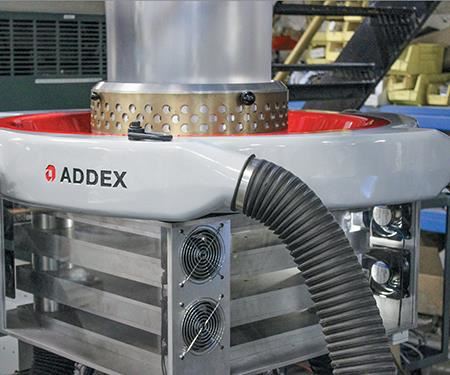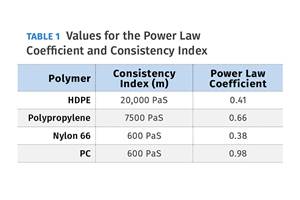Stackable Bubble-Cooling Rings Offer Huge Output Gains
Next-generation bubble-cooling system is said to boost throughputs by as much as 60% in blown film.
Addex Inc., has taken decades-old cooling technology originally developed by a processor and improved it to create a new device that is said to offer dramatic increases in blown film output. Called ICE—for Intensive Cooling Experience—the unit has been running for months on Addex’s pilot line in Newark, N.Y., as well as at some beta sites. In these trials, it has reportedly been shown to increase output by 40-60% over what can be generated from lines equipped with just conventional air-ring technology.
ICE consists of a series of stackable cooling rings that surround the bubble, explains Bob Cree, Addex president. Each of these rings—or elements—direct divergent air streams along the bubble, both upward and downward, to provide high film-holding forces and peak cooling efficiency. These high-performance divergent cooling elements are assembled using spacer pipes that also provide a common feed of cooling air to each cooling ring, says Cree. The stack mounts above the top of the die, and is topped with an air ring.
ICE comes standard with four stackable cooling elements. Two elements are the minimum, but Cree says almost any number can be stacked to achieve the desired output gains. Each element is said to offer a 10-15% increase in output compared with a line having only a dual-flow air ring. Cree says Addex has tested ICE with various air-ring designs and is now running trials using it with IBC.
The stack comes furnished with the ICE Enclosure, which replaces the surrounding atmosphere with a very stable, controllable ambient pressure. Each enclosure includes a combination of flow buffers and multiple low-pressure, bladed fans to operationally set the pressure differential between the inside and outside of the bubble. The system includes easy-to-interpret operator feedback and adjustment for optimizing the stability and cooling efficiency of this enclosed, stacked cooling system.
Addex has patents pending on the device. ICE will be shown in a static display at the Addex booth at the upcoming K 2016 Show, Oct. 19-26 in Dusseldorf, Germany. It could also be running on lines of various other blown-film machinery OEMs at the show.
A previous iteration of this technology was patented in 1975 by Mobil Chemical Co. and was used extensively on that company’s blown film lines to produce a range of products. Called the Herrington Stack (after its developer Jack Herrington), the unit helped Mobil produce “billions of pounds of products,” recalls Cree, who worked for Mobil in Macedon, N.Y., for five years as a group leader in R&D before co-founding Addex in 1990.
Originally, the device was intended to impose a specific shape on the bubble to permit the manipulation of physical properties, notes Cree. The dramatic increases in output came as a surprise. “The Herrington Stack literally took cooling to the limit of what the polymer can handle before ripping to pieces,” he recalls. At the same time, he says, it “enhanced physical properties of the film due to its ability to impose a preferred shape to the bubble.”
But the system also caused significant gauge variation and bubble instability and was extremely noisy in operation. These issues cropped up particularly when processing lower-melt-strength materials. “Bubble flutter within the cooling stack caused gauge variations that resulted in scrap,” says Cree. “Also, the stack created a very loud shrieking sound.”
Mobil tried various methods to solve these problems, and once the patent expired others reportedly tinkered with the original design as well. Addex began its own R&D project in mid-2014, and went through dozens of different design iterations. In the Herrington Stack, air was directed to the bubble upward and downward—creating an air-knife or vacuum effect—through a series of holes drilled through a plenum. Among other things, the Addex ICE uses circular slits in the form of nozzles instead of drilled holes to create an annular flow of high-velocity air around the bubble at exit velocities similar to a dual-lip air ring.
Addex began testing ICE on thick TPU and has since run it on a wide range of other materials, including LLDPE, LDPE blends, PP, and nylon 6/66. “We are locking the bubble in at every point of contact between air and film,” Cree reports. “We are achieving the output gains provided by the original stack, but bubble stability is far superior.”
As a result, gauge variation of the film at start-up is reportedly the same or better when compared with a line with a conventional air ring (before activating any auto-profile device). Processors that have tested ICE-produced films reported no significant changes in physical properties compared with films made with conventional technology, says Cree.
ICE can be retrofitted in cases where lines are not already running at maximum output rates.
Related Content
Fully Automated Extrusion Process Enables Use of Composites for Manufacturing Pressure Tanks
Amtrol was looking for a more cost-effective means to produce thin-wall liners for a new line of pressure tanks. With the help of a team of suppliers, they built one of the world’s most sophisticated extrusion lines.
Read MoreUnderstanding Melting in Single-Screw Extruders
You can better visualize the melting process by “flipping” the observation point so that the barrel appears to be turning clockwise around a stationary screw.
Read MoreAvoid Four Common Traps In Granulation
Today, more than ever, granulation is an important step in the total production process. Our expert explains a few of the many common traps to avoid when thinking about granulators
Read MoreThe Importance of Viscosity in Melting
The calculations required to determine the right melt temperature for each polymer are complicated. Knowing the power-law coefficient and the consistency index of the polymer you run might prove useful.
Read MoreRead Next
Troubleshooting Screw and Barrel Wear in Extrusion
Extruder screws and barrels will wear over time. If you are seeing a reduction in specific rate and higher discharge temperatures, wear is the likely culprit.
Read MoreLead the Conversation, Change the Conversation
Coverage of single-use plastics can be both misleading and demoralizing. Here are 10 tips for changing the perception of the plastics industry at your company and in your community.
Read MoreProcessor Turns to AI to Help Keep Machines Humming
At captive processor McConkey, a new generation of artificial intelligence models, highlighted by ChatGPT, is helping it wade through the shortage of skilled labor and keep its production lines churning out good parts.
Read More










.png;maxWidth=300;quality=90)

















